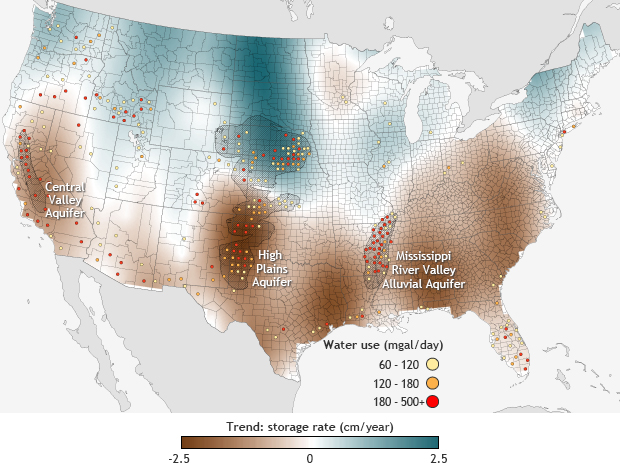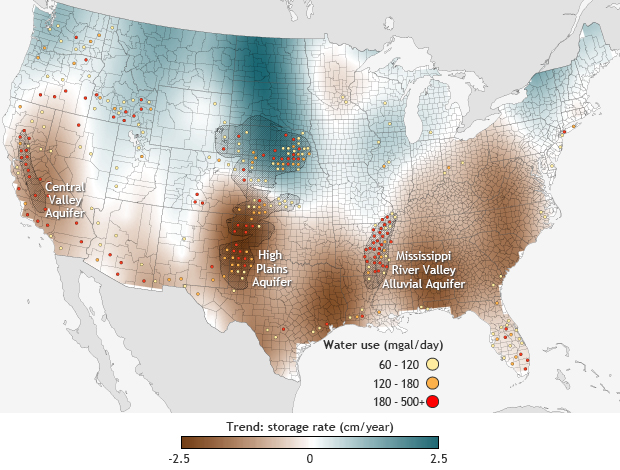Category 4
Category 3
Category 2
Category 1
We specialize in elevating content creators like you through bespoke social media strategies that not only capture attention, but also drive engagement.
Stride Social
Welcome to
I was sitting in an airport, scrolling through my inbox, when an article from The New York Times caught my eye: America Is Using Up Its Groundwater Like There’s No Tomorrow. The piece was accompanied by a map that showed, in stark contrast, the dramatic loss of groundwater across the U.S. over the last 80 years. Where once there were deep blue areas representing abundant water reserves, now there were red dots—signs of depletion, of wells running dry. I couldn’t look away. This wasn’t just a distant issue; this was happening in my own backyard in Oxnard, California.
Groundwater is ancient, taking millions of years to accumulate beneath our feet. And yet, within the span of just a few generations, we’ve drawn down these reserves at an unsustainable rate. Each year, enough groundwater is lost to fill 150,000 Olympic-sized swimming pools. And in drought years? The deficit is even greater.

Map of the United States showcasing ground water loss over the past 10 years
Credit: climate.gov
I’ve spent years researching water use in our food system, asking one question over and over: How can we eat in a way that conserves water rather than depletes it? The answer lies in understanding the concept of virtual water footprint—the hidden water embedded in our food.
Take a slice of bread, for example. It requires 11 gallons of water to produce. A pound of beef? A staggering 1,800 gallons. And chocolate—everyone’s favorite treat—takes a jaw-dropping 7,727 gallons of water per pound. These numbers tell a powerful story: the higher a food is on the food chain, the more water it takes to produce. But what’s equally important is where that water is coming from.
Green Water vs. Blue Water: Why It Matters
Not all water is the same.
- Green water is rainfall—water that falls from the sky, is absorbed by healthy soil, and sustains crops without the need for irrigation.
- Blue water comes from underground aquifers, rivers, and reservoirs. This is the water we are using too quickly, treating it as if it were a renewable resource when, in fact, it is not.
When farmers rely on groundwater for irrigation, they are pumping ancient reserves faster than nature can replenish them. And as water levels drop, they must drill deeper and deeper—sometimes thousands of feet down—just to keep their farms alive. In places like California’s Central Valley, this has led to entire communities losing access to drinking water because they cannot afford to dig new wells.
Farming for the Future: The Power of Soil
A few years ago, I visited a wheat farmer in Paso Robles, California. Unlike his neighbors, who were growing water-intensive crops like almonds and grapes using deep wells, this farmer was practicing dry farming. His wheat fields thrived without irrigation, drawing only on the moisture stored in the soil.
How? The secret was in the soil itself.
Healthy soil, rich in organic matter, acts like a sponge. It can hold up to 10,000 times more water than soil degraded by industrial agriculture. Instead of running off or evaporating, rainwater is absorbed, stored, and slowly released to nourish crops. When farmers prioritize soil health, they reduce their need for irrigation and help replenish groundwater instead of draining it.
Unfortunately, industrial farming—fueled by fossil-based fertilizers and chemical pesticides—does the opposite. It strips soil of its organic matter, leaving it dry and lifeless, requiring more and more irrigation to sustain crops. This cycle is unsustainable, but we have the power to break it.
What Can We Do? Three Steps to Protect Groundwater with Our Food Choices
As kitchen activists, the choices we make at the table send ripples through the food system. Here’s how we can take action:
- Eat Organic Whenever Possible
- Organic farming builds healthy soil, reducing the need for irrigation and helping to recharge groundwater.
- Organic fields also absorb more carbon, making them a powerful tool in the fight against climate change.
- Support Small, Regenerative Farmers
- Many small-scale farmers use water-saving methods like dry farming, crop rotation, and cover cropping to conserve resources.
- Shopping at farmers’ markets and choosing brands committed to regenerative practices helps shift demand away from industrial agriculture.
- Eat Lower on the Food Chain
- When organic isn’t available, choosing plant-based options can still make a significant difference.
- A pound of tomatoes requires just 13 gallons of water, while a pound of cheese takes 414 gallons, and butter requires an astounding 3,602 gallons.
Even small changes—opting for plant-based meals more often, choosing organic strawberries over conventional ones, or seeking out pasture-raised meats—add up. Every decision we make at the table shapes the future of our water supply.
A Collective Movement for Change
The loss of groundwater isn’t just a regional issue; it affects us all. The strawberries I saw on the streets of Brooklyn last week? They were likely grown in my hometown of Oxnard, where groundwater levels are in critical decline. The onions being harvested outside my door this morning? They will be shipped across the country and around the world, carrying with them a hidden cost in the form of lost water reserves.
But we are not powerless. By shifting our food choices, we can become part of the solution. We can protect the groundwater beneath our feet, nourish our bodies, and support farmers who are working with the land, not against it.
Thank you for joining me on this journey. Let’s keep the conversation going. Sign up for my newsletter for more tips on eating sustainably and join me back here next Wednesday. Together, we will write a new story for this planet—one meal at a time.
If you enjoyed this post, please consider reviewing my book, Eat Less Water, or sharing this blog. Together, we can amplify the message and inspire more kitchen activists.
Link to purchase a copy of my award winning book Eat Less Water:
https://www.florenciaramirez.com/book/
Link to the podcast this blog was based on:
Leave a Reply Cancel reply
Ready to take Action?

click to Read & Leave a comment
Click to close comments
Comments